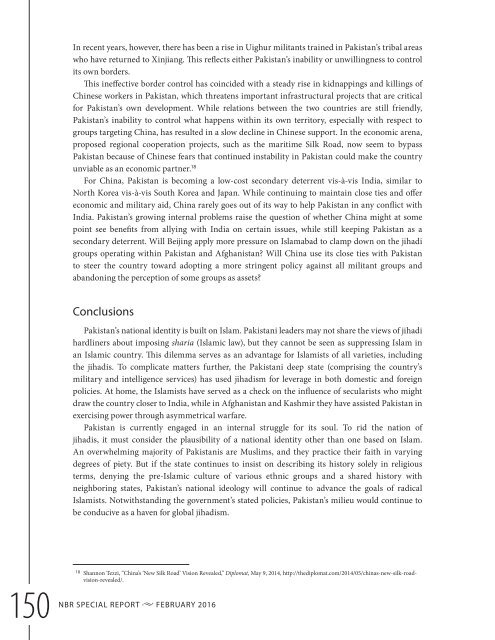pakistan’s
SR55_Mapping_Pakistan_February2016
SR55_Mapping_Pakistan_February2016
Create successful ePaper yourself
Turn your PDF publications into a flip-book with our unique Google optimized e-Paper software.
In recent years, however, there has been a rise in Uighur militants trained in Pakistan’s tribal areas<br />
who have returned to Xinjiang. This reflects either Pakistan’s inability or unwillingness to control<br />
its own borders.<br />
This ineffective border control has coincided with a steady rise in kidnappings and killings of<br />
Chinese workers in Pakistan, which threatens important infrastructural projects that are critical<br />
for Pakistan’s own development. While relations between the two countries are still friendly,<br />
Pakistan’s inability to control what happens within its own territory, especially with respect to<br />
groups targeting China, has resulted in a slow decline in Chinese support. In the economic arena,<br />
proposed regional cooperation projects, such as the maritime Silk Road, now seem to bypass<br />
Pakistan because of Chinese fears that continued instability in Pakistan could make the country<br />
unviable as an economic partner. 18<br />
For China, Pakistan is becoming a low-cost secondary deterrent vis-à-vis India, similar to<br />
North Korea vis-à-vis South Korea and Japan. While continuing to maintain close ties and offer<br />
economic and military aid, China rarely goes out of its way to help Pakistan in any conflict with<br />
India. Pakistan’s growing internal problems raise the question of whether China might at some<br />
point see benefits from allying with India on certain issues, while still keeping Pakistan as a<br />
secondary deterrent. Will Beijing apply more pressure on Islamabad to clamp down on the jihadi<br />
groups operating within Pakistan and Afghanistan? Will China use its close ties with Pakistan<br />
to steer the country toward adopting a more stringent policy against all militant groups and<br />
abandoning the perception of some groups as assets?<br />
Conclusions<br />
Pakistan’s national identity is built on Islam. Pakistani leaders may not share the views of jihadi<br />
hardliners about imposing sharia (Islamic law), but they cannot be seen as suppressing Islam in<br />
an Islamic country. This dilemma serves as an advantage for Islamists of all varieties, including<br />
the jihadis. To complicate matters further, the Pakistani deep state (comprising the country’s<br />
military and intelligence services) has used jihadism for leverage in both domestic and foreign<br />
policies. At home, the Islamists have served as a check on the influence of secularists who might<br />
draw the country closer to India, while in Afghanistan and Kashmir they have assisted Pakistan in<br />
exercising power through asymmetrical warfare.<br />
Pakistan is currently engaged in an internal struggle for its soul. To rid the nation of<br />
jihadis, it must consider the plausibility of a national identity other than one based on Islam.<br />
An overwhelming majority of Pakistanis are Muslims, and they practice their faith in varying<br />
degrees of piety. But if the state continues to insist on describing its history solely in religious<br />
terms, denying the pre-Islamic culture of various ethnic groups and a shared history with<br />
neighboring states, Pakistan’s national ideology will continue to advance the goals of radical<br />
Islamists. Notwithstanding the government’s stated policies, Pakistan’s milieu would continue to<br />
be conducive as a haven for global jihadism.<br />
150<br />
NBR<br />
18 Shannon Tezzi, “China’s ‘New Silk Road’ Vision Revealed,” Diplomat, May 9, 2014, http://thediplomat.com/2014/05/chinas-new-silk-roadvision-revealed/.<br />
SPECIAL REPORT u FEBRUARY 2016



